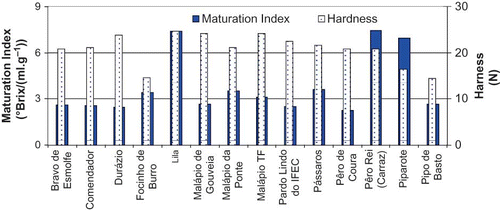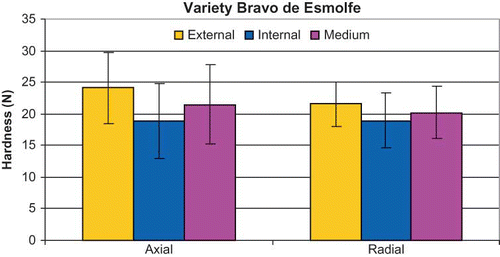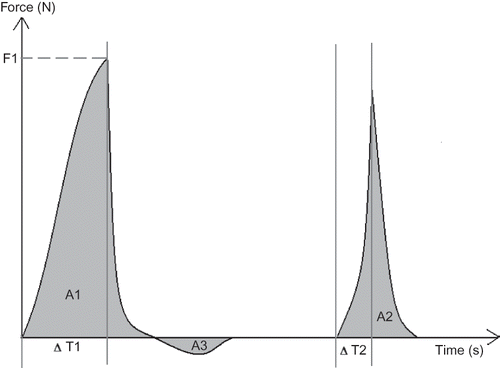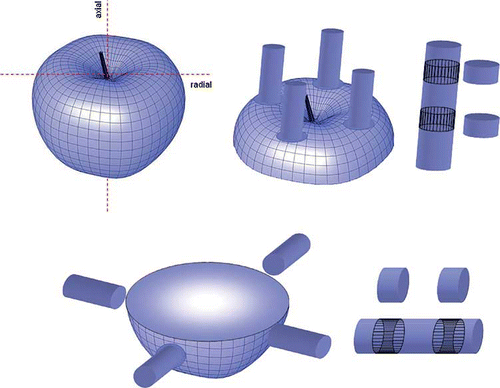Abstract
Regional varieties of apples present an endogenous patrimony that should be preserved and promoted to guarantee biodiversity of genetic resources. In the present work, Texture Profile Analysis (TPA) was performed to apples of fourteen different regional varieties, having in consideration the spatial geometry of the fruits, and the textural parameters: hardness, adhesiveness, springiness, cohesiveness, and chewiness were assessed. The samples to perform the TPA's were obtained from different locations in the fruit–external and internal–and considering axial and radial orientations. The results of these analysis performed allowed us to conclude that the apples from regional varieties showed different textural properties among themselves. Furthermore, it was generally observed that hardness does not vary much according to the internal or external location of the sample, but varies quite significantly according to the orientation, being generally higher for the axial measurements. From the present work, it was possible to conclude that, in terms of textural properties, the varieties studied showed important differences.
INTRODUCTION
After all citrus, grapes and banana, apples are the fourth most important tree fruit crop worldwide.[Citation1] Apples of regional varieties present an endogenous patrimony that must be preserved and even promoted to guarantee biodiversity of genetic resources. However, these regional varieties are not at all characterized in scientific terms, and therefore some work has been done in Portugal aiming at characterizing these varieties, either in morphological or in physicalchemical terms.
The texture of apples is one of the most important quality parameters that influence the consumer's acceptability. Cell adhesion and loss of firm texture are associated with ripening and affect fruit quality and postharvest storage in a considerable extent. The changes occurring in the cell wall's structure and composition clearly determine fruit firmness.[Citation2–5] A better knowledge of apple physical properties is of importance to select new varieties with lower bruise susceptibility[Citation6] and higher acceptability.
From a sensory point of view, texture is generally defined as the overall feeling that a food gives in the mouth, and therefore, it is comprised of properties that can be evaluated by touch.[Citation7] However, in a more specific way, texture is composed of several textural properties which involve different types of characteristics: mechanical (hardness, chewiness, and viscosity), geometrical (particle size and shape), and chemical (moisture and fat content).[Citation8] Quantitative texture measurements allowed us to obtain information concerning certain parameters such as hardness, cohesiveness, adhesiveness and springiness.[Citation9]
Instrumental measurements of fruit texture have become basilar for the management of quality in the apple industry.[Citation10] Fruit firmness, in general, decreases as fruits become more mature and decreases rapidly as they ripen.[Citation11] Instrumental texture profile analysis (TPA) is one of the methods to determine the texture by simulating or imitating the repeated biting or chewing of a food. Traditionally, in most techniques for the evaluation of fruit mechanical properties, the fruit is assumed as a continuum material in which the mechanical properties essentially do not depend on the spatial scale. However, fruits consist of different tissues, and their macroscopic mechanical behaviour depends on several microscopic properties.[Citation12] In the present work, Texture Profile Analysis (TPA) was performed to apples from different regional varieties, having in consideration the spatial geometry of the fruits. In fact, it is quite difficult to find in literature works about texture of foods in general, and apples in particular, that include the spatial variability, thus justifying the present study.
MATERIALS AND METHODS
In the present study, the following 14 regional varieties of apples from Portugal were analyzed: Bravo de Esmolfe, Comendador, Durázio, Focinho de Burro, Lila, Malápio de Gouveia, Malápio da Ponte, Malápio TF, Pardo Lindo do IFEC, Pássaros, Pêro de Coura, Pêro Rei Carrazeda, Piparote, and Pipo de Basto. These apples were harvested in the year 2005, and were collected in an Orchard of the Agrarian Station of Viseu that belongs to the Minister for Agriculture, Rural Development and Fisheries. The TPA's were performed on the apples right after they were harvested; therefore, no storage was required.
The texture profile analysis was performed using a Texture Analyzer (model TA.XT.Plus, from Stable Micro Systems, UK) with a P/75 Probe. The parameters of the determinations were pre-test = 0.50 mm/s, test speed = 0.50 mm/s, post-test speed = 1.00 mm/s, target mode = distance, distance = 1.200 mm, time = 5.00 s, trigger type = auto (force), trigger force = 5 g. The textural properties: hardness, adhesiveness, springiness, cohesiveness, and chewiness were then calculated after standard equations[Citation13] ():
The samples to perform the TPA's were obtained from different locations in the fruit (external and internal) and considering different orientations (axial and radial), as seen in . The samples consisted of discs with 8-mm diameter and 4-mm thickness. For each variety, 4 apples were analyzed and 64 TPA's were obtained, 32 relating to axial samples and 32 to radial samples.
RESULTS AND DISCUSSION
shows the relation between the Maturation Index (MI) of the different varieties together with the corresponding value for hardness, to perceive whether there was the same direct relation between these two properties for all varieties studied. In fact, it was possible to observe that for most varieties with a low MI (under or slightly above 3 °Brix/(ml.g−1)) the hardness was high (over 20 N). However, the varieties Focinho de Burro and Pipo de Basto despite having also MI around 3 °Brix/(ml.g−1) present Hardness of about 15 N, meaning that these varieties are softer. On the other hand, varieties Lila, Pêro Rei Carrazeda and Piparote are harder varieties, since they show much higher Maturation Indexes for the same magnitude of Hardness (around 20 N).
Figure 3 Maturation index (MI = soluble solids/acidity) and hardness of the different varieties of apples analyzed. (Figure provided in color online.)

summarises the medium values of hardness, and the corresponding standard deviations, for the different varieties studied in different locations and considering different orientations: inside the fruits in the axial direction and in the outer part of the fruits in both directions (axial and radial). From the results obtained, it was possible to observe that generally the determinations made in the axial orientation are higher than those made in the radial orientation. Exceptions are the varieties Malápio de Gouveia, Pardo Lindo do IFEC and Piparote. Globally, considering both orientations, the harder varieties are Durázio, Lila, Malápio de Gouveia and Malápio TF, whereas the softer are Focinho de Burro and Pipo de Basto. Furthermore, when the results were according to the location in the apple: near the surface (external) or near the core (internal), it was verified that the hardness of the external measurements was in general higher that that of the internal ones, except for the varieties Comendador, Pêro Rei Carrazeda, and Pipo de Basto. Additionally, by comparing the hardness measured at the surface of the apples from determinations made in the axial and radial orientations, was generally observed that the axial determinations were higher than the radial ones, except for the varieties Pardo Lindo do IFEC, Pêro Rei Carrazeda, Piparote and Pipo de Basto. The results found for the surface of the apples are in accordance with those for the whole apple, as stated before. Konopacka and Plocharski[Citation14] reported that for ‘Jonagold’ and ‘Gloster’ apples stored in controlled atmosphere, higher values of optimum firmness and wider ranges of highly acceptable firmness were found than for normal atmosphere-stored apples. However, for ‘Elstar’ apples such differences were not observed.
Table 1 Hardness of the different apple varieties, according to position and orientation (the values in brackets represent the corresponding standard deviations)
The graph in shows for one variety of apples chosen the various determinations made for hardness, i.e., different orientations and different locations in the apple. The variety selected was Bravo de Esmolfe, which from the regional varieties studied, is the one with higher commercial expression at present. The importance of the acceptability of these regional varieties is of great interest, since they are more resistant to pests, such as scab, and, therefore, their commercial potential is increased. Kühn and Thybo[Citation15] studied the consumer acceptance of twenty-two scab-resistant apple cultivars. Texture attributes, among others were affected by storage, so that extended storage resulted in an increase in mealiness and overripe flavor and a decrease in crispness, juiciness, and apple flavor. The graph shows that external hardness is higher than internal, being this difference more accentuated in the axial direction. Inside the apple, the hardness is not so influenced by the orientation in which the measurements are made.
Figure 4 Hardness for different locations and orientations in apples of the variety Bravo de Esmolfe. (Figure provided in color online.)

presents the values obtained for different textural properties (adhesiveness, cohesiveness, springiness and chewiness) for the tests made in axial and radial directions, together with the corresponding standard deviations. Regarding adhesiveness the apples of all varieties showed a very low value, generally, which indicates that they did not have measurable adhesiveness. This result indicates that the work necessary to overcome the adhesive forces between the surface of the fruit, and the surface of the other material in contact with it, is similar and very low. Although adhesiveness is negligible, when comparing the different varieties studied, the variety Durázio is that with the higher value in both directions, being the difference even more visible for the axial direction. Major differences in the physical and chemical characteristics of apple cuticle have long been known and are thought to affect adhesiveness.[Citation16,Citation17] Paoletti et al.[Citation18] studied selected commercial apple cultivars (Golden Delicious, Stark Delicious, Renetta, Annurca, Granny Smith, and Emperor) to discriminate among the cultivars and the different levels of merceological quality for their mechanical and texture characteristics, using instrumental and sensory methods. They found out that Annurca and Granny Smith cultivars showed the highest values for almost all the instrumental and sensory parameters measured.
Table 2 Different textural properties in apples of regional varieties, measured in axial and radial directions (the values in brackets represent the corresponding standard deviations)
Considering cohesiveness, the results in showed that, for all varieties, this property was higher in the axial measurements than in the radial ones. This indicates that the strength of internal bounds in the fruit that keep the sample cohesive is higher in the axial direction. Cell walls provide support to plant cells, as well as support for the cohesiveness of the plant tissue. The cohesiveness of the plant tissue, therefore, is determined by the amount of pectic substances at the middle lamella.[Citation19] The cell membrane structure can be quite different depending on the direction considered, causing the cohesiveness to increase in the axial direction.
In relation to springiness, it is known that this textural attribute is related to the capacity with which the fruit recovers its shape after compression. From the values calculated after the axial and radial TPA's performed with the different regional varieties of apples (), it was observed that most of the apples presented higher values for springiness in the axial direction, 8 varieties against 5 which presented lower values. Curiously, the variety Pêro Rei Carrazeda presented the same springiness independently of the orientation of the sample. These results are slightly more conclusive than those found by Mavroudis et al.[Citation20] when studying different Swedish apple varieties. In fact, with respect to springiness, due to high variation in the values obtained they were not able to draw any conclusions about the difference between springiness values of samples from the inner and outer cortex with the same orientation. Comparing samples originating from similar tissue structures (either inner or outer cortex) in the Mutsu apple variety, a pronounced influence of the sample orientation on the springiness values was observed.
The textural property chewiness represents the energy necessary to disintegrate a solid food to swallow it. The results obtained for this property in the apple varieties studied ( considers that the axial directions are higher for almost all varieties, except for Pardo Lindo do IFEC and Piparote). This is in accordance with the results previously presented, since the chewiness is equal to the product of hardness by cohesiveness and by springiness (EquationEq. (5)). In fact, as seen previously, these two varieties are those where the hardness in the radial direction clearly surpassed that of the axial direction.
CONCLUSIONS
The results of the present work enabled us to conclude that the regional varieties of apples showed different textural properties among themselves, being the varieties Durázio, Lila, Malápio de Gouveia and Malápio TF the harder ones, and Focinho de Burro and Pipo de Basto the softer. As to the influence of the type of sample, it was generally observed that hardness did not vary much according to the position in the apple (internal or external), but varied quite significantly according to the orientation, being generally higher in the axial measurements.
REFERENCES
- Farris , S. , Gobbi , S. , Torreggiani , D. and Piergiovanni , L. 2008 . Assessment of two different rapid compression tests for the evaluation of texture differences in osmo-air-dried apple rings . Journal of Food Engineering , 88 ( 4 ) : 484 – 491 .
- Redgwell , R.J. , MacRae , E. , Hallet , I. , Fischer , M. , Perry , J. and Harker , R. 1997 . In vivo and in vitro swelling of cell walls during fruit ripening . Planta , 203 : 162 – 173 .
- Waldron , K.W. , Smith , A.C. , Parr , A.J. , Ng , A. and Parker , M.L. 1997 . New approaches to understanding and controlling cell separation in relation to fruit and vegetable texture . Trends in Food Science & Technology , 8 : 213 – 221 .
- Marsilio , V. , Lanza , B. , Campestre , C. and De Angelis , M. 2000 . Oven-dried table olives: textural properties as related to pectic composition . Journal of the Science of Food and Agriculture , 80 : 1271 – 1276 .
- Billy , L. , Mehinagic , E. , Royer , G. , Renard , C.M.G.C. , Arvisenet , G. , Prost , C. and Jourjon , F. 2008 . Relationship between texture and pectin composition of two apple cultivars during storage . Postharvest Biology and Technology , 47 ( 3 ) : 315 – 324 .
- Grotte , M. , Duprat , F. , Loonis , D. and Pitri , E. 2001 . Mechanical properties of the skin and the flesh of apples . International Journal of Food Properties , 4 ( 1 ) : 149 – 161 .
- Sams , C.E. 1999 . Preharvest factors affecting postharvest texture . Postharvest Biology and Technology , 15 : 249 – 254 .
- Bourne , M.C. 1980 . Texture evaluation of horticultural crops . HortScience , 15 : 51 – 56 .
- Houjaij , N. , Dufresne , T. , Lachance , N. and Ramaswamy , H.S. 2009 . Textural Characterization of Pureed Cakes Prepared for the Therapeutic Treatment of Dysphagic Patients . International Journal of Food Properties , 12 ( 1 ) : 45 – 54 .
- Harker , F.R. , Gunson , F.A. and Triggs , C.M. 2006 . Apple firmness: Creating a tool for product evaluation based on a sensory–instrumental relationship . Postharvest Biology and Technology , 39 ( 3 ) : 327 – 330 . 2006
- Jarimopas , B. and Kitthawee , U. 2007 . Firmness Properties of Mangoes . International Journal of Food Properties , 10 ( 4 ) : 899 – 909 .
- Alamar , M.C. , Vanstreels , E. , Oey , M.L. , Moltó , E. and Nicolaï , B.M. 2008 . Micromechanical behaviour of apple tissue in tensile and compression tests: Storage conditions and cultivar effect . Journal of Food Engineering , 86 ( 3 ) : 324 – 333 . 2008
- Kotwaliwale , N. , Bakane , P. and Verma , A. 2007 . Changes in textural and optical properties of oyster mushroom during hot air drying . Journal of Food Engineering , 78 : 1207 – 1211 .
- Konopacka , D and Plocharski , W.J. 2004 . Effect of storage conditions on the relationship between apple firmness and texture acceptability . Postharvest Biology and Technology , 32 ( 2 ) : 205 – 211 .
- Kühn , B.F. and Thybo , AK. 2001 . Sensory quality of scab-resistant apple cultivars . Postharvest Biology and Technology , 23 ( 1 ) : 41 – 50 .
- Pierzynowska-Korniak , G. , Zadernowski , R. , Fornal , J. and Nesterowicz , J. 2002 . The microstructure of selected apple varieties . Electron. J. Pol. Agric. Univ. , 5 ( 2 ) : 13
- Spottsa , R.A. , Wallisa , K.M. , Serdanib , M. , O'Gormanc , D.T. and Sholbergc , P.L. 2009 . Real time polymerase chain reaction for rapid and quantitative determination of Cystofilobasidium infirmominiatum on the surfaces of apple, pear, and sweet cherry fruit . Postharvest Biology and Technology , 51 ( 2 ) : 227 – 231 .
- Paoletti , F. , Moneta , E. , Bertone , A. and Sinesio , F. 1993 . Mechanical Properties and Sensory Evaluation of Selected Apple Cultivars . Lebensmittel-Wissenschaft und-Technologie (LWT) , 26 ( 3 ) : 264 – 270 .
- Khina , M.M. , Zhou , W. and Yeoa , S.Y. 2007 . Mass transfer in the osmotic dehydration of coated apple cubes by using maltodextrin as the coating material and their textural properties . Journal of Food Engineering , 81 ( 3 ) : 514 – 522 .
- Mavroudis , N.E. , Dejmek , P. and Sjöholm , I. 2004 . Studies on some raw material characteristics in different Swedish apple varieties . Journal of Food Engineering , 62 ( 2 ) : 121 – 129 .

